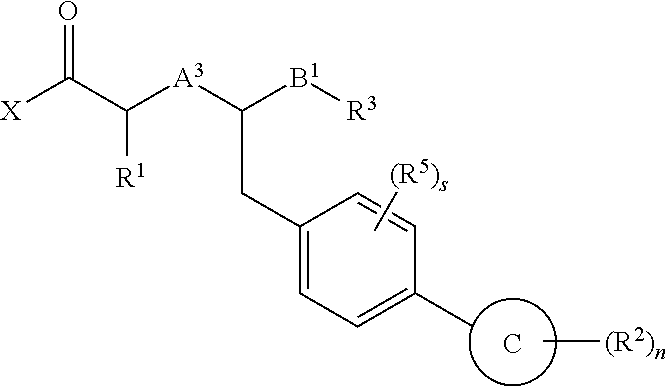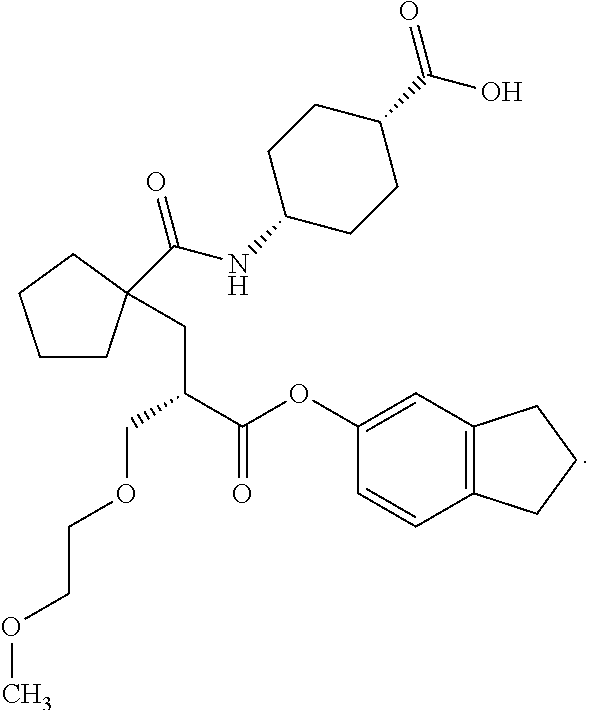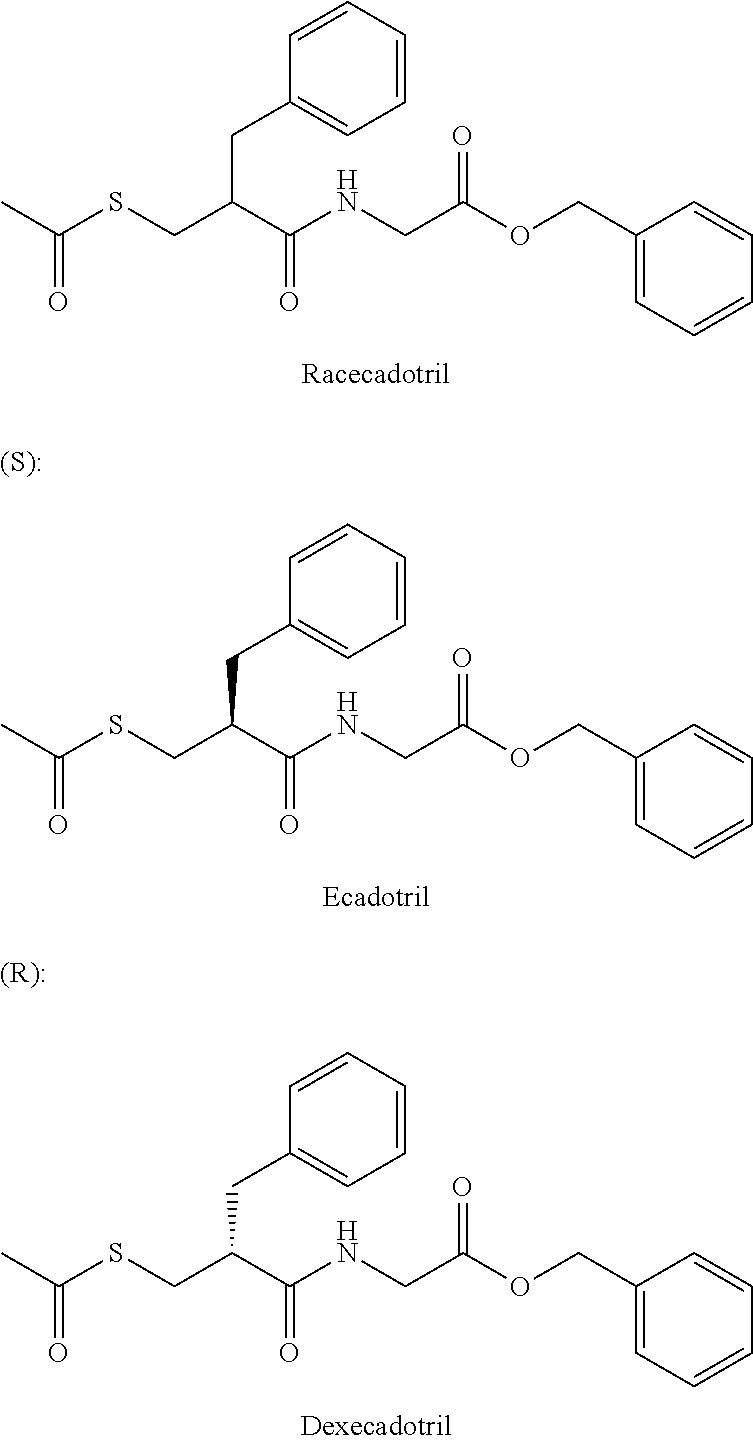Method of treating contrast-induced nephropathy
a nephropathy and contrast-induced technology, applied in the field of contrast-induced nephropathy, can solve the problems of increasing the risk of this renal failure, the incidence of cin has not been definitively shown to decrease the incidence of cin, and the risk of nephropathy and other problems, to achieve the effect of treating, preventing or ameliorating contrast-induced nephropathy
- Summary
- Abstract
- Description
- Claims
- Application Information
AI Technical Summary
Benefits of technology
Problems solved by technology
Method used
Image
Examples
example 1-1
Synthesis of (R)-4-(1-(biphenyl-4-yl)-4-ethoxy-4-oxobutan-2-ylamino)-4-oxobutanoic acid
[0367]
[0368]To (R)-ethyl-4-(biphenyl-4-yl)-3-(tert-butoxycarbonylamino)butanoate (230.1 mg, 0.600 mmol) is added a solution of HCl in 1,4-dioxane (3.00 mL, 12.00 mmol) at room temperature. After stirring for 1 hour, the reaction mixture is concentrated under reduced pressure to give (R)-3-amino-4-biphenyl-4-yl-butyric acid ethyl ester hydrochloride. A solution of (R)-3-amino-4-biphenyl-4-yl-butyric acid ethyl ester hydrochloride, succinic anhydride (72.1 mg, 0.720 mmol) and DIPEA (0.126 mL, 0.720 mmol) in dichloromethane (4 mL) is allowed to stir for 1 hour. The reaction is quenched with 10% aqueous citric acid and extracted with dichloromethane. The organic layer is separated and concentrated under reduced pressure. The obtained residue is purified by flash column chromatography on CN-modified silica gel (eluent: heptane / EtOAc=100:0 to 0:100) and by RP-HPLC (SunFire C18, H2O (0.1% TFA) / CH3CN) to ...
example 1-2
Synthesis of (R)-4-(1-(3′-chlorobiphenyl-4-yl)-4-ethoxy-4-oxobutan-2-ylamino)-4-oxobutanoic acid
[0369]
[0370]A solution of (R)-ethyl 3-amino-4-(3′-chlorobiphenyl-4-yl)butanoate hydrochloride (400 mg, 1.13 mmol), succinic anhydride (136 mg, 1.36 mmol) and DIPEA (0.237 mL, 1.36 mmol) in dichloromethane (5 mL) is allowed to stir for 2.5 hours. The reaction is quenched with 1 M aqueous HCl and extracted with dichloromethane. The organic layer is separated and concentrated under reduced pressure. The resulting residue is purified by preparative HPLC using a gradient of 20% MeCN / water (0.1% TFA) to 100% MeCN to give (R)-4-(1-(3′-chlorobiphenyl-4-yl)-4-ethoxy-4-oxobutan-2-ylamino)-4-oxobutanoic acid (255 mg). HPLC retention time=1.15 minutes (condition B); MS (m+1)=418.0; 1H NMR (400 MHz, CHLOROFORM-d) δ ppm 1.29 (t, J=7.08 Hz, 3H) 2.46-2.58 (m, 4H) 2.64-2.67 (m, 2H) 2.87 (A of ABX, Jab=13.6 Hz, Jbx=7.8 Hz, 1H) 2.99 (B of ABX, Jab=13.6 Hz, Jbx=6.6 Hz, 1H) 4.12-4.24 (m, 2H) 4.47-4.55 (m, 1H)...
example 1-3
[0373]1H NMR (400 MHz, CHLOROFORM-d) δ ppm 2.41-2.45 (m, 2H) 2.50-2.64 (m, 4H) 2.81-2.87 (m, 1H) 2.95-3.00 (m, 1H) 4.49-4.56 (m, 1H) 5.12 (A of AB, J=12.1 Hz, 1H) 5.18 (B of AB, J=12.1 Hz, 1H) 6.39 (d, J=8.1 Hz, 1H) 7.18-7.54 (m, 13H).
PUM
| Property | Measurement | Unit |
|---|---|---|
| Temperature | aaaaa | aaaaa |
| Volume | aaaaa | aaaaa |
| Mass | aaaaa | aaaaa |
Abstract
Description
Claims
Application Information
 Login to View More
Login to View More - R&D
- Intellectual Property
- Life Sciences
- Materials
- Tech Scout
- Unparalleled Data Quality
- Higher Quality Content
- 60% Fewer Hallucinations
Browse by: Latest US Patents, China's latest patents, Technical Efficacy Thesaurus, Application Domain, Technology Topic, Popular Technical Reports.
© 2025 PatSnap. All rights reserved.Legal|Privacy policy|Modern Slavery Act Transparency Statement|Sitemap|About US| Contact US: help@patsnap.com



